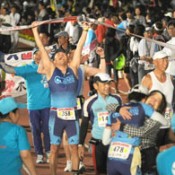
April 22, 2013 Ryukyu Shimpo
The 29th All Japan Triathlon Miyako-jima (co-hosted by Miyako-jima City and the Ryukyu Shimpo) was held on April 21 but had the swim part of the race canceled due to strong winds. As a result, it changed to a run-bike-run duathlon.
This is the first time that such a duathlon has been held instead of the scheduled triathlon. The race started with a run of about 6.5 kilometers, then the bike section of 155 kilometers, and finally another run of 42.195 kilometers, making a total distance covered of about 204 kilometers. Anton Balokhin from the Ukraine won the men’s race and Goertz Beate from Germany won the women’s race, both securing their second consecutive titles.
Balokhin completed the men’s race in a time of 7 hours 31 minutes 36 seconds. In second place was Yuto Kawara from Tokyo, and in third was Masayuki Matsumaru from Ibaraki.
Goertz in the women’s race won with a time of 8 hours 27 minutes 58 seconds. The runner-up was Emi Sakai from Tokyo, and third was Lee Ji-hyeon from Korea.
A total of 1470 competitors (1294 male and 176 female) took part in the event and 1184 (1060 male and 124 female) completed the race. The race-completion rate was 80.5 percent and, while a comparison cannot be made with the regular event, this rate is the lowest ever in the Miyako Triathlon.
The weather was cloudy, the temperature at noon was 18.6 C with the wind speed 7.3 meters per second.
(English translation by T&CT, Lima Tokumori and Mark Ealey)
Go to Japanese

Go To Video
April 24, 2013 Ryukyu Shimpo
On April 22, during a trip to the United States, Susumu Matayoshi, the head of the Executive Office of the Governor, met Christopher Johnstone, the Pentagon director for Northeast Asia, and Marc Knapper, director of the Office of Japanese Affairs at the Department of Defense. Matayoshi explained to them that the Okinawa Prefectural Government (OPG) will continue to demand the relocation of U.S. Marine Corps Futenma Air Station outside of Okinawa. Utilizing an electronic conferencing system, on April 23 he talked about his meetings in the United States at a press conference held for Okinawan reporters. Matayoshi said, “Some people seem to be optimistic that the governor of Okinawa is leaning toward accepting land reclamation for alternative facility at Henoko in order to commence the relocation of Futenma Air Station, but I strongly asserted that the OPG will continue to demand the relocation of the base outside of Okinawa.”
Matayoshi explained that the OPG’s position reflects the opinion of the municipalities in Okinawa regarding a return and integration plan to give back land currently used for the five U.S. military facilities located south of Kadena.
The U.S authorities stated that the current agreement reached between the U.S. and Japanese governments is the only way to avoid Futenma Air Station becoming a permanent fixture, and that there is no alternative plan. They reiterated their intention to implement the current Henoko relocation plan.
Matayoshi met Mike Mochizuki, a professor of George Washington University. Mochizuki expressed the view that the integration plan did not directly achieve the understanding of Okinawan people.
This is the first time that the OPG has held a press conference utilizing an electronic conferencing system.
(English translation by T&CT, Mark Ealey)
Go to Japanese
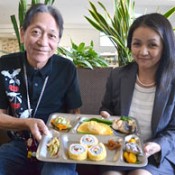
April 15, 2013 Ryukyu Shimpo
Colorful ingredients add beauty to an otherwise stark stainless steel plate. Until about ten years ago, at ceremonial occasions held in Minami Daito Village it was the custom to serve food on ex-U.S. military stainless steel plates. Now using this as a tourism promotion, the Minami Daito Tourism Association has created a new menu item called Daito Gozen using a range of local ingredients. Ryukyuan cuisine and sushi rolls, which were introduced by people from Hachijo Island who settled on Minami Daito about 100 years ago, will feature in the dish. It will be a champuru-type dish distinctive to the “migrants’ island” and will be served at local hotels and restaurants.
This is a part of the Minami Daito Village Branding Project. Encouraging local production and consumption, large quantities of locally produced pumpkins, potatoes and fish will be used.
Stainless steel plates were purchased at ex-military products stores on the main island of Okinawa and brought to Minami Daito Island around 1948. Islanders appreciated them and used them on ceremonial occasions. Currently the Association is working on creating recipes. Ideas include date maki, which was introduced from Hachijo Island, sautéed snack mackerels caught in the waters around the island, and yokan (bean jelly) made of the squash produced in the village, the island’s unique dish Daito omelets served with steamed potatoes.
Sample dishes will be provided to tourists this month and the association will then survey the tourists and make use of their feedback.
Administration Officer Atsushi Kumakiri of the Tourism Association said, “Daito Island is at the junction of Ryukyuan and Hachijo influences. It has a unique culture not found on other remote islands where people live.”
Association President Yoshizato said, “In addition to Daito sushi and soba, we want to promote a new range of dishes created within the island’s natural environment. I would like visitors to learn about our food as well as the environment.”
(English translation by T&CT, Megumi Chibana and Mark Ealey)
Go to Japanese
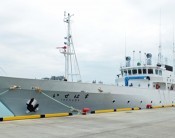
April 14, 2013 Ryukyu Shimpo
It was announced on April 13 that a Fisheries Agency patrol vessel has been deployed continually at Hirara Port in Miyako-jima this month. The agency also revealed their intention to constantly deploy two fisheries patrol vessels at Ishigaki-jima, but the date for their deployment has not been finalized. This was announced by Tokuyuki Sudo, the manager of the agency’s Resources Management Department who visited Miyako-jima and Ishigaki on April 13. In response to the conclusion of the Japan-Taiwan Fisheries Agreement, the Japanese government will strengthen its crackdown on illegal fishing boats in the seas surrounding Japan.
The agency’s fisheries patrol vessels are always stationed at the mainland of Okinawa, but it is the first resident deployment in the Sakishima area.
The fisheries patrol vessel Isehama (499 tons, 17 crew) has been in Hirara Port since April 11. It is scheduled to depart on patrol on April 15. The purpose of the fisheries patrol vessel is to monitor the illegal operation of fishing boats. The agency conducts on-site inspections when they find a fishing boat suspected of illegal activity. Unlike the Japan Coast Guard’s vessels, a fisheries patrol vessel does not deal with intrusions into territorial waters. The agency has received approval from the Miyako-jima authorities to use Hirara Port for one year.
On the morning of April 13, Sudo visited Miyako-jima Mayor Toshihiko Shimoji at the city hall to thank him for granting approval to use the port. In keeping with the conclusion of the Japan-Taiwan Fisheries Agreement, he said, “We must crack down on the illegal fishing boats completely. We have a home port right here in front of us (in the waters recognized by the agreement), and it is necessary to establish a system that we can implement quickly in the case of a crisis. The Japan-Taiwan border is close to the north of the Sakishima Islands, and we have agreed on a demarcation line with Taiwan in that area. If any boat crosses the line even slightly we will come down on them hard.”
Mayor Shimoji said, “Many Taiwanese boats will come soon. We hope that the Japanese government will handle them firmly.”
On the afternoon of the same day, in a meeting with Ishigaki Mayor Yoshitaka Nakayama, Sudo explained the plan for ongoing deployment of two fisheries patrol vessels at Ishigaki.
(English translation by T&CT, Lima Tokumori and Mark Ealey)
Go to Japanese
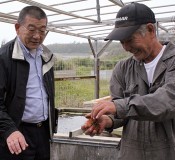
April 14, 2013 Ryukyu Shimpo
In Iwaki, Fukushima Prefecture, the tsunami that followed the Great East Japan Earthquake destroyed the port facilities and the radioactive leaks from the Fukushima-1 plant damaged the fishing grounds.
Kazuyoshi Suzuki, the head of the Iwaki Fisheries Cooperative, and someone who used to catch northern sea urchin, has started to try land-based breeding of Okinawa collector sea urchins in Tohoku after learning breeding techniques from the Okinawa Prefectural Collector Urchin Breeding Business Union in Uruma.
There are many challenges but, “We can’t just stand still,” says Suzuki. Northern sea urchin served on top of surf clam was a famous dish in Iwaki, but now it is hard to find. Everything was washed away by the tsunami, the ground level dropped in eleven places and because the sea is affected by radiation reconstruction for the fishing ports is still a distant goal. Only trial operations are possible at the moment. Even so, Suzuki has not given up on the reconstruction.
The Okinawa Industry Support Center introduced him to the business union, which breeds collector urchins and releases them in the sea around Okinawa.
Because the Iwaki Fisheries Cooperative has not used any breeding techniques this was an innovative idea for them. It takes five to eight years to breed the northern sea urchin but just a year or so for the collector sea urchins in Okinawa. Suzuki wants to try to stop union members from leaving the fishing industry to look for land-based jobs because the compensation paid by Tokyo Electric Power Company for loss of income is not enough to live on.
Suzuki visited Okinawa on April 4 and was taught about breeding techniques by Takeshi Ganeko, a member of the union who is in charge of the process. The business union is seeking to obtain cooperation from Uruma in order to expansion of its breeding facilities, and wants to support Suzuki for the sake of the reconstruction of Tohoku.
However, staff of the Okinawa Cultural Fishery Center have suggested that this is unrealistic because while breeding collector sea urchin works in a temperate region, it will not in Tohoku, which is a cold region. There are many challenges and the cost of feeding and maintaining the water temperature is very high. On top of that, Suzuki still needs to get the conservative Iwaki Fisheries Union to understand the new breeding process.
Be that as it may, Suzuki said, “We still need to try to do what we can do.” Many people died in the earthquake and survivors were forced from their homes because of the nuclear accident. The radiation has polluted the seawater, and the presence or absence of compensation from the Tokyo Electric Power Company and the difference in the amount of such payments has affected people’s relationships, with them often becoming awkward and complicated. Suzuki said, “Because of these challenges, I want to work hard to reconstruct the community through the fishing industry. When it succeeds, it will be a great opportunity to link Fukushima with Okinawa that has provided support for us.”
(English translation by T&CT, Hitomi Shinzato and Mark Ealey)
Go to Japanese
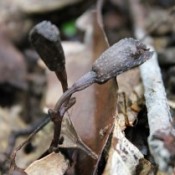
April 21, 2013 Jun Kinjo of Ryukyu Shimpo
On April 20, Chosei Tamaki, the head of the Move Through Nature of Yambaru Association, an environmental non-governmental organization, confirmed the presence in the forest of the Takae district of Higashi of rare species of plants such as an orchid newly discovered in Taiwan last year and Maesa japonica, a type of shrub included on the critically endangered category of the IUCN Red List of Threatened Species. Tamaki called for the preservation of these valuable natural resources, saying, “The U.S. military plans to construct helipads in Takae, but the district preserves nature unique to the Yambaru area of the northern part of Okinawa, and its flora could even be termed a ‘museum’ of rare species.”
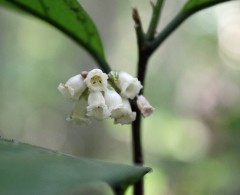
Maesa japonica photographed in 2009. It appears to be established in the forest of Takae (Photograph taken by Chosei Tamaki).
A professor at the University of the Ryukyus, Masatsugu Yokota, who is an expert in plant taxonomy, said that the scientific name of the newly-discovered orchid will be Gastrodia clausa, and its Japanese name will be the
tsubomi-yatsushiro orchid. After the orchid was found in Taiwan, the same variety has recently been discovered in Okinawa. A paper about the orchid will be published soon.
Although the presence of Maesa japonica has been reported for two places in Okinawa, it is highly likely that it has since become extinct in one of them. Takae will be the third place where the plant is found.
In 2009 Tamaki confirmed the presence of Maesa japonica for the first time. Since then, he has seen it blossom every year and he thinks that the plant is established in Takae.
To begin with, some experts judged the newly discovered orchid to be Gastrodia nipponica because of the similarity of its nature and shape, but Yokota pointed out that the plant is a new variety of orchid.
In addition to these, Tamaki confirmed the presence of several endangered species in the forests of Takae such as Taeniophyllum glandulosum and the ghost orchid.
With regard to the discovery of the new orchid, Tamaki said, “I was really surprised. I want to use this opportunity to make the Okinawan people aware of the need to protect this valuable forest.”
Yokota pointed out that the three factors such as 1) the extinction of autogenesis ground due to exploitation, 2) plant collecting and 3) natural calamities and pests could cause the extinction of these plants. Tamaki referred to the significance of protecting the native habitat of the forest from exploitation and other threats, saying, “Exploitation of autogenesis ground reduces the number of many species, but because the number and the autogenesis ground of animals and plants in Okinawa is limited to start with most are threatened by the factors just mentioned.”
(English translation by T&CT, Mark Ealey)
Go to Japanese
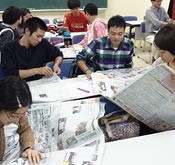
April 17 2013 Ryukyu Shimpo
On April 16, at the University of the Ryukyus in Nishihara, the Ryukyu Shimpo newspaper and the university’s Faculty of Education cooperated to start delivering a newspaper course. The course aims to teach students the role and structure of newspapers by introducing examples of NIE (Newspapers in Education) to students who hope to become teachers.
Twenty students took the course, studying about the dissemination of the concept of NIE.
Hitoshi Fukuhara, the new deputy chief editorial writer, will deliver the course in the first semester.
Fukuhara told the students that there is a correlation between interest in news and academic achievement and that people enhance their reading capacity by reading newspapers. He explained that schools in Okinawa deliver a range of courses that take advantage of newspapers in accordance with NIE policies within the new curriculum guidelines.
Working in groups, students discussed articles that they were interested in.
Senior student Chihiro Furutani said, “I think that just reading the headlines gave us topics for conversation, and just five minutes of reading an article stimulated interest in society in all sorts of ways. From now, I want to read newspapers every day.”
(English translation by T&CT, Mark Ealey)
Go to Japanese
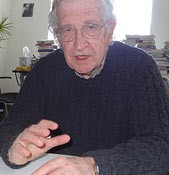
April 22, 2013 Hideki Matsudo of Ryukyu Shimpo
Noam Chomsky, a linguistics professor who is one of the most outspoken critics of U.S. foreign policy, which he characterizes as hegemonic, gave an interview with the Ryukyu Shimpo on the U.S. military issue in Okinawa. He criticized the governments of Japan and United States for trying to forcibly relocate the functions of the Futenma base to Henoko in Nago, saying, “It shouldn’t be moved elsewhere in Okinawa either. The people of Okinawa, as far as I can see, don’t want it, and they are the ones who should decide.” Dr. Chomsky, 84, is an emeritus professor at Massachusetts Institute of Technology and is also known a philosopher and a logician. He is the author of many books dealing with social and political issues, and was selected among the world’s top public intellectuals in 2005. The interview was conducted in late March at his office in Boston, Massachusetts.
Chomsky emphasized that the Japanese and U.S. Governments should respect the will of the people in Okinawa on the Futenma relocation issue. He stated that U.S. foreign policies in Southeast Asia and in the Middle East have consistently to undermine democracy. He also agreed with the opinion that the spirit of democracy, which is a national policy of the United States, had not been reflected in matters concerning Okinawa.
Referring to the current reality in which Okinawan people shoulder the heavy burden of hosting U.S. bases, he said, “The reason goes back to the end of the Second World War, and the U.S. had insisted that the Peace Treaty with Japan be completely [carried out] under U.S. control,” said Chomsky. “The U.S. set up a series of military bases to essentially control that region, and Okinawa was one. Japan assumed a position subordinate to the United States.” Chomsky sees that the nature of the relationship between the two countries lies at the root of the Okinawa problem.
(English translation by T&CT, Mark Ealey)
The following is the full transcript of the interview with Dr. Noam Chomsky
Interview with Dr. Noam Chomsky
by Hideki Matsudo of Ryukyu Shimpo
March 23, 2013
MATSUDO: I would like to ask you about the U.S. military presence in Okinawa.
DR. CHOMSKY: Well, the reason goes back to the end of the Second World War, and the U.S. had insisted that the Peace Treaty with Japan be [carried out] completely under U.S. control. The other allies were not permitted to participate. In fact, if you take a look at the San Francisco Peace Treaty of 1951, not only were other… I mean nominally other allies were allowed to attend, but the U.S. ran it all, unlike say, in Europe, where there was participation. This was going to be U.S. territory.
To make it even sharper, the treaty with Japan and the War Crimes Trials and the Tokyo Tribunal, kept to crimes that were committed from 1941. Now, for the rest of Asia that was a bitter insult because the war and started ten years earlier and there were plenty of crimes in the 1930s but they were excluded. In fact, it was so extreme that the countries of Asia that were more or less independent just refused to participate. Take a look at the participation in the San Francisco Treaty. There was the Philippines under U.S. control. I think there was Ceylon, which was still a British colony. But, the major countries just refused to come.
The U.S. set up a series of military bases to essentially control that region, and Okinawa was one, and it has been used in extremely dangerous ways. It was only learn recently that in 1962, right before the Cuban Missile Crisis, the U.S. shipped advanced missiles with nuclear warheads to Okinawa, aimed at China. If you remember, then it was a period of significant military tension. There was a war between China and India and so on. I mean, that was a very provocative move.
And in general it’s been… I won’t run through the history, but today it’s part of the so-called “pivot to Asia,” a greater U.S. military presence in the Pacific, of course aimed at China. It’s a continuation, modified because of different circumstances, but a continuation of the effort to maintain a dominant position in determining the affairs of the region. That’s a lot harder to do now. The U.S., in 1945, really did control the world and a few years later that had already changed and China was liberated and later the countries in Southeast Asia began to move toward some degree of independence and brutal wars followed. It’s a horrible story. Later, the former Japanese colonies, Taiwan and South Korea, began their industrial development, and actually picked up from where it had been before, and now were partially independent and more free and the whole region is much more diverse.
Japan, on the contrary, remains very much subordinate to the United States. Recall when there was an effort by a Japanese prime minister to offer Okinawa some support in its effort to remove the base. He was immediately thrown out. He couldn’t sustain himself under American pressure. It was just a couple of years ago.
Q: The U.S. Marine Corps Air Station Futenma is located in the densely populated area of Ginowan City. The governments of Japan and the United States are moving ahead with a controversial plan to build an alternative facility for the Futenma base at Henoko. What do you think about this?
DR. CHOMSKY: Well, that shouldn’t be allowed. But also, it shouldn’t be moved elsewhere in Okinawa either. The people of Okinawa, as far as I can see, don’t want it and they are the ones who should decide. Just as is say China wanted to put a military base outside of Boston, people in Massachusetts ought to decide.
That raises a broader question, of whether Okinawa should be subject to Japan. Look, historically Okinawa was a more or less independent country. Until Japan conquered it, it was an independent country. So, if the Okinawans want to stay as part of Japan, okay that’s their business. But, if they want to be independent they should be free to do so.
Okinawa may now become inadvertently part of some serious confrontations in the region. So the islands, what Japan calls the Senkaku Islands, China the Diaoyu Islands, are not very far from Okinawa. In fact they’re close to Taiwan, but Japan itself is very remote, but Okinawa is not too far. Undoubtedly, the military bases on Okinawa will be part of the U.S. backing for Japan in what could turn out to be a serious confrontation. I mean, China and Japan are in a conflict over who owns the islands, and Taiwan is making a claim to them also, although nobody hears them very much. They’re not that powerful. But, that could flare up into a more serious confrontation. There already have been some minor confrontations, jet planes, and scrambling that kind of thing, naval vessels and so on. And, Okinawa is part of the backup. The U.S. has a Treaty with Japan to support it if there is any military conflict, and Okinawa could be drawn into a major military conflict. I don’t expect it to happen but it’s always possible when there are military bases. And, these are forward bases for the United States, just as they were in 1962 when the U.S. put nuclear missiles there.
Q: North Korea has announced that their missiles aimed at US bases on Okinawa.
DR. CHOMSKY: North Korea is so unpredictable that it’s hard to say. It’s not exactly a normal regime. But, I’m very skeptical of that. I mean, if you look over the history of North Korea, it’s a very erratic regime. But still, if you look, I think they have been pretty consistent in keeping to what strategists have called a “tit for tat” relationship with South Korea and United States. If they’re given some concession they react with a concession. If there is what they take to be a hostile act, they respond with a hostile act, and sometimes they do violent things. But, it’s been pretty constrained.
In fact, if you look at the history there have been ways to try to reduce the confrontation. In 1994, there was the Framework Agreement with Clinton. There was a North Korea-U. S. agreement, which neither side kept too perfectly, but it was more or less observed. In fact, when George W. Bush came into office, North Korea had maybe one or two nuclear weapons and nothing under development, which was an indication that the Agreement had been more or less observed by both sides. Bush took a stance, which the North Koreans regarded, and correctly, as very harsh. They were condemned as an “Axis of Evil” and so on, and they reacted by energizing the nuclear weapons program. By the time Bush left office they had eight or ten nuclear weapons and were developing more.
If you look through that period there were a few moments when steps were taken towards conciliation. I think it was in 2005 that an agreement was reached in which the United States would provide North Korea with a reactor for medical and other purposes, and would enter into and there would be kind of a non-aggression pact and some mutual steps towards accommodation. Then right after that North Korean began to reduce its nuclear proposals. However, the Bush Administration almost immediately condemned North Korea for various financial and other crimes, and broke the agreement, didn’t provide the reactor and so on that, and North Korea again took off on a nuclear program and very inflammatory statements and so on and so forth.
A couple of years later the Bush Administration right at the end of 2008, backed off and moved towards reinstating the Agreement and at that point withdrew the original charges. Washington observers concluded that the reason probably was that the new agreement will lead to inspections and it would be determined that the charges were wrong, and so it goes on.
Right now, North Korea is reacting in what appears to be these verbally violent ways, with the kinds of threats you’re talking about. Two actions that they regard as hostile, like the South Korean-U.S. military exercises, and the building of the military base on Jeju Island and so on.
So I presume that the threats are mostly for domestic consumption, using the only way they know or that’s part of their nature now to try to move toward some kind of negotiation, mainly by being obnoxious and inflammatory. I hope so at least. If that is right, then there are ways to approach it, but the chances of them bombing an American military base, I think, are pretty low. I mean, the country will be wiped out with retaliation.
Q: The Japanese Government and the U.S. Government say to the Okinawan people that the U.S. presence on Okinawa is necessary in order to be ready in the unstable security situation in the region. They have put 74 percent of all U.S. military bases in Japan into Okinawa.
DR. CHOMSKY: Well, it’s needed for “stability,” but stability is a funny term in international politics. So for example, Iran is accused of destabilizing its neighbors. What that means is that Iran is trying to extend its influence in neighboring countries, in Afghanistan and in Iraq. Well, when we extend our influence into other countries that’s not called destabilizing. That’s called stabilizing. And in fact, when the U.S. invades those countries and half destroys them, that’s not called destabilizing. That’s called stabilizing, which illustrates the way the term is used. Stability means conformity to our demands.
In fact, sometimes it reaches almost absurd levels. For example, one of the leading foreign policy analysts, a liberal and dovish foreign policy analyst, was explaining the U.S. participation in the overthrow of the democratic government of Chile, and what he said was that we had to destabilize Chile in order to bring about stability. It sounds like a contradiction, unless you understand the words. What it meant was that we had to undermine and help destroy the Chilean democratic system in order to bring about conformity to what we wanted.
And I think Okinawans, when they hear the word “stability,” should think about what it means and has always meant in international affairs. It means “doing what we say.” It’s not a contribution to stability when the U.S., for example, under the Kennedy Administration, put offensive nuclear missiles on Okinawa. It’s not a contribution to stability if the U.S. begins to play some role in supporting the Japanese claim in a conflict over the islands, which could lead to a very serious complication. In fact, Okinawa would suffer from that.
Q: Okinawan people have requested that the governments of the United States and Japan reduce the U.S. footprint on Okinawa and relieve our burden. However, they have been there for 67 years. We truly believe in the spirit of democracy of the United States, but it has never been realized in Okinawa.
DR. CHOMSKY: Well, for one thing, if you look over the history, including the U.S., there is no correlation between whether an imperial country is democratic or autocratic. There is no correlation between that and their imperial policies. Like, if Britain was maybe the most democratic country in the world at the time when British imperialism was carrying out horrendous atrocities in its colonies, and the same is true of the United States. The United States is a relatively democratic country, and it may be one of the more democratic countries, but its policies in Southeast Asia and in Latin America, and in the Middle East have been consistently to undermine democracy. I mean, over and over again.
The U.S. took the lead, along with Britain in overthrowing the democratic government of Iran in 1953, because it wanted to control their oil. The Iranian Government was trying to control its own resources. U.S. and Britain wouldn’t accept that. A year later, in 1954, the U.S. overthrew the first democratic government in Guatemala, because it was beginning to distribute land to peasants, the organized peasant majority, and the U.S. and U.S. corporations didn’t like that. So, it continues. The overthrow of the Allende Regime in Chile was not because the U.S. wanted a democratic regime. It helped to overthrow a democratic regime and it backed a brutal dictatorship. And the whole of history runs like that.
In fact, right at this moment the U.S. is trying, along with Britain and France and the other major powers, to try to prevent the democratic developments in the Middle East and in the North African region. So they are backing the oil dictatorships in maintaining stability. That means repressing the move towards democracy and reform. Both France and the United States and England in the background, supported the dictatorships and North Africa to the last minute. France in Tunisia and the United States in Egypt, both backed the dictators until they had actually been virtually overthrown from within and then shifted. And that’s the whole of history, and England was the same way, other imperial powers were the same way.
If they are imperial powers, they are interested in domination and control, and not in sponsoring a democratic process and for obvious reasons. If you allow democracy the people are going to want you to get out. So obviously you’re not going to sponsor democracy.
Q: Okinawa is one of the poorest prefectures in Japan because the U.S. military occupies land.
DR. CHOMSKY: I don’t think it’s trying to make Okinawa poor. It’s just the consequence of the policies that it follows. In fact, it’s sort of interesting. If you look at the whole imperial system during the great period of imperialism, Japan, which was a pretty brutal imperial power, nevertheless, was almost alone in that it actually developed its colonies. So South Korea and Formosa, which is now Taiwan, were brutally treated by Japan, but they did develop more or less as fast as Japan did. That is certainly not true of the countries under British and American and French rule. They just collapsed. In fact, the only other example of this, interestingly, is Russian. If you take a look at Russia and Eastern Europe, Russian was pretty brutal in Eastern Europe. Even the CIA point out that they were the first empire in which the colonies were richer than the imperial power. The eastern European countries were richer and more advanced than Russia was. Not because Russia was a nice country, but because they wanted to ensure their subordination to Russia. So they subsidized them.
So the correlation between the level of democracy or autocracy in a country and its attitudes, its policies towards its colonies, is just not there, as these examples show, it was often to the contrary.
So, the United States is not trying to make Okinawa poor. It’s just carrying out policies that prevented it from developing, which is the typical imperial role, to prevent development. Japan and Russia were a little unusual in this respect.
Q: Do you think there is a possibility that the U.S. Government would create tensions in the region?
DR. CHOMSKY: I don’t think the U.S. government is purposefully creating confrontation, but actions it takes do increase confrontation. We see it in North Korea. The U.S.-South Korean military maneuvers are creating tension. The construction of the naval bases on Jeju Island, the military base, it is a bit like Okinawa. The population is strongly opposed and protesting and constant protests and been repressed and so on. It’s also leading to potential tensions with China, because clearly, the base is aimed at China, 500 kilometers away. The whole base structure is a source of confrontation.
The United States is the only country that has a huge base structure all over the whole world. France has a few bases, but almost no other country has bases anywhere else. There are maybe 1,000 of them, and they are always a source of confrontation.
In fact, al Qaeda turned against United States because of the U.S. military bases in Saudi Arabia. The Pentagon recognized that publicly said that it wanted to move its bases out of Saudi Arabia because they were leading to the revival of Jihadi terrorism. People don’t like to have military bases in their country, as you know, for perfectly good reasons. They want their own country. They don’t want to be drawn into broader confrontations.
Q: Is there any way that the Okinawan people can reduce the U.S. presence on this island?
DR. CHOMSKY: Well, the only way available to them is significant protests. It should be a non-violent protest, in cooperation with others. There are American groups that are opposed to the bases, struggling to remove them. There ought to be interaction. In fact, there is some interaction. There ought to be closer interaction and mutual support. And also with groups in Japan that want to free themselves from the whole base structure and the confrontational structure that comes with it. There are probably groups all over, including in the United States and in Japan, that want to do this in cooperation with people on Okinawa. They can help in this common effort. There are just no other means available. And sometimes it succeeds. You know? Bases do get removed. Frankly, I doubt that the United States is going to be able to maintain its international military basing system for a very long time. The United States is no longer as financially dominant as it was, or diplomatically dominant as it was in the past.
For example, in Latin America. Latin America used to be just the backyard, and it did whatever the U.S. wanted. There isn’t a single U.S. military base left in South America. They’ve all been kicked out. The last military base was in Ecuador, and the U.S. wanted to maintain it, but the President of Ecuador made a nice comment. He said, well, you can maintain a military base here if Ecuador can put a military base next to Miami. (laughter) They withdrew the base. That’s pretty spectacular. They U.S. is trying to reintroduce a military presence, but it’s not succeeding.
In fact, the extent to which Latin America has freed itself from Western domination is pretty spectacular and people should pay attention to it. Because, you know, this was the most subordinate place. It had been under almost total European domination, first European and then American domination for 500 years. In the last, roughly 10 or 15 years, it has almost totally liberated itself. People here don’t’ like to talk about it, but should be observed by people in Okinawa and in other countries that are in somewhat similar situations.
There was a remarkable illustration of a just a few weeks ago. There is an organization in the United States called The Open Society Institute. It’s funded by George Soros. They came out with the study called Globalizing Torture. It’s about the U.S. international torture campaign based on what is called “Rendition,” taking suspects and sending them to brutal dictatorships, where they can be tortured.
It turns out that the study was investigating which countries participating in that. It requires international cooperation, and it turns out that most of Europe participated. The Middle East participated, because that’s where they were sent to be tortured, to the dictatorships of Egypt, and Syria and Libya and so on. Asia and Africa participated somewhat.
There was one region of the world, which truly refused to participate, South America. If you look at history, that is simply astonishing. For one thing, Latin America was always “under the thumb” of the West, mostly the U.S., in the last century or so. And secondly, during this whole period, Latin America itself was one of the torture centers of the world. Some of the worst torture anywhere was going on in Latin America. Well now, in just ten years, they have been refusing to participate in the “globalized torture” campaign. So dramatic illustration of what popular movements can achieve, freeing themselves from external domination, and it’s a model for others.
Q: Do you have any message for the Okinawan people?
DR. CHOMSKY: Well, I think be hopeful, and it’s possible to achieve quite a lot. There have been many advances over the years. What I just mentioned is one striking one, but it’s not the only one. The power in the world is becoming more diverse. The U.S. is still far in the lead, but it’s much more diverse and it offers plenty of opportunities. There are new centers of power developing like the so-called BRICs countries… Brazil, Russia, India, China. South Africa and maybe Indonesia might join, which are taking a somewhat independent stance in affairs. They don’t have the power to achieve a lot, but it’s moving in that direction. China can be a threat, and I think the countries of Southeast Asia and the region are right to be concerned about the expansion of Chinese power. But on the other hand it may turn out to be a constructive force too. There are a lot of possibilities in the world, and a small place like Okinawa can’t control events, but it can act in ways that will help liberate itself and that will indeed be an inspiration to others.
Go to Japanese
April 13, 2013 Ryukyu Shimpo
On April 12, the Okinawa Prefectural Government (OPG) asked the Okinawa Defense Bureau to make corrections to the written application that the central government has submitted to the Governor of Okinawa. This is part of the process for seeking approval for the landfill in Henoko, Nago, to build the alternative facilities for the U.S. Marine Corps Air Station Futenma. The OPG pointed out that the application had a total of 33 flaws in 13 sections, including insufficient detail. Before the agency submitted the application, the OPG asked the bureau to clearly specify the amount of sediment to be used for the landfill, the location for collecting this and the access route to be used. Despite being asked to do so, the bureau did not specifically provide these details in the document. The OPG has requested that the central government submit the corrections by June 11.
In the application form, the bureau wrote that the location for collecting the sediment was to be “Okinawa, Kyushu and the Seto Inland Sea,” but did not specify the names of municipalities involved. The OPG considers that the Henoko Fishing Port breakwater will be rendered ineffective by the landfill, and has asked the bureau to get a letter of consent from the Nago Municipal Office, which constructed the breakwater, or to attach a document giving the reason why such consent is not forthcoming from the municipal office. The OPG also requested that the government make mention of the findings on the presence or absence of hazardous substances in the sediment. The OPG has published the details of the corrections it requires on its website.
After the bureau submits the necessary corrections, it will take two or three weeks to get the documents ready for public inspection, which is a procedural step for the reclamation. Public inspection will then be carried out over three weeks at the OPG’s offices in Naha and at the Hokubu Engineering Office in Nago. After that, once he reviews the content of the application and consults with the mayor of Nago, Governor Hirokazu Nakaima will determine whether or not he will approve the reclamation. The OPG considers that it will require from six and a half months to eight and a half months to get the governor’s decision on the landfill. In addition to this, it can take a considerable amount of time to review the environmental impact statement, which is attached to the application, and the task may become drawn-out.
Director of the Okinawa Defense Bureau Hirofumi Takeda commented on the request from the OPG for amendment, saying, “We will go through its content and respond appropriately and carefully.”
The corrections requested by the OPG:
The Okinawa Defense Bureau must submit the corrections to the document to the OPG by June 11.
• Specify the presence or absence of hazardous substances in the landfill soil.
• Provide a statement from the Nago mayor on the potential impact on the breakwater at Henoko Fishing Port.
• Describe in detail the amount of sediment required, the location of collecting this sediment and the access route to carry this out.
(English translation by T&CT, Mark Ealey)
Go to Japanese
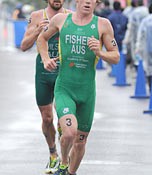
April 15, 2013 Taichi Hirayasu of Ryukyu Shimpo
The Ishigaki ITU Triathlon World Cup 2013 and Ishigaki Triathlon 2013 were held on Ishigaki Island on April 14. The two events were co-organized by Ishigaki City, the Triathlon Union, Ryukyu Shimpo, Okinawa Television Broadcasting Co., Ltd. and Nikkan Sports News. In the women’s World Cup race, Ai Ueda (Shaklee, Greentower, Inage Inter), Yuka Sato (Toshin Partners, Team Ken’s) and Juri Ide (Toshin Partners, Team Ken’s) dominated the top results. In the men’s World Cup race, Ryan Fisher, who showed his strength in the run, won his first victory. Among the Japanese athletes, Ryosuke Yamamoto (Kitajima Aquatics) came in 6th, and Yuichi Hosoda (Tokushima Triathlon Association) ranked 8th. In the Ishigaki Triathlon, Kanji Kuwabara and Keiko Tanaka who both belong to Team Goya won the top prize of their age group in the men’s and women’s races. A total of 1106 people took part in the age group race, and 1029 people completed the full distance. Some 137 groups participated in the relay race, with 127 groups managing to complete the whole distance.
In the World Cup Section, Fisher overwhelmingly triumphed over Keane by one minute.
Ryan Fisher (Australia), who won his first victory, seemed greatly relieved when he finished the race. In the adverse conditions of muddy roads and rain during the bike section, many athletes fell over. It was a tough competition in which seven athletes dropped out. “It was dangerous unless I was careful, so I tried to stay focused until the very end,” Fisher, recalled with a smile.
In the swim, he was well positioned to take the lead from the opening lap. Then he kept up the pace on the bike. He said, “I went well today. I was really careful to avoid slipping.” Fisher stayed sharp as many people fell off their bikes.
Going into the run, Fisher showed his strength. In the opening part of the run, Dan Wilson, who is also from Australia, kept up with Fisher in second place but Fisher said, “I thought I would come out ahead if we got into arm wrestle.” Fisher gradually left Wilson behind and had established a large lead by the end of the race. In the end he beat Bryan Keane (Ireland) by nearly one minute.
Fisher, who took part in the Ishigaki Triathlon World Cup two years ago, said, “This is a special tournament for me.” With his first victory crown secured, he said, “It is a special victory, and I’m happy to manage this good result.”
(English translation by T&CT, Lima Tokumori and Mark Ealey)
Go to Japanese

Go To Video












 Webcam(Kokusai Street)
Webcam(Kokusai Street)


